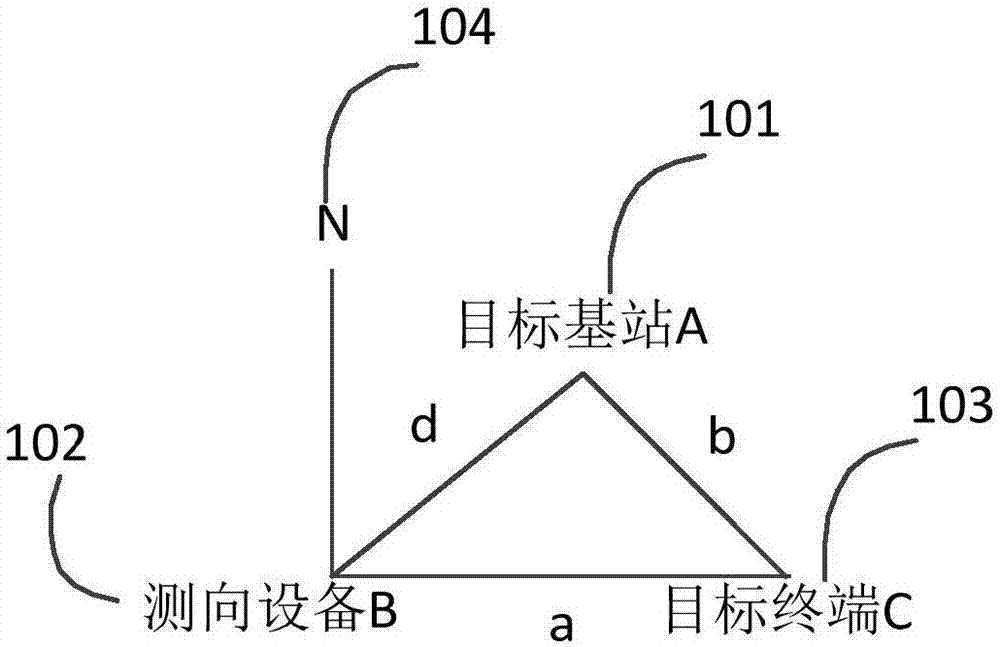Method for positioning base station and terminal
A technology for locating base stations and terminals, applied in electrical components, wireless communications and other directions, can solve problems such as unfavorable third-party direction-finding equipment locating target terminals, difficult access to base station location information, and lack of target base station location information. Effect
- Summary
- Abstract
- Description
- Claims
- Application Information
AI Technical Summary
Problems solved by technology
Method used
Image
Examples
Embodiment 1
[0076] In general, such as figure 1 As shown, the locations of the target base station 101 and the target terminal 103 are unknown. In this embodiment, the steps of using the third-party direction-finding device 102 to locate the target base station 101 and the target terminal 103 are as follows:
[0077] Step 101: The third-party direction-finding device 102 acquires the timing t when the downlink signal of the target base station 101 arrives at the direction-finding device 102 0 ;
[0078] Step 102: The third-party direction-finding device 102 determines that the AoA (Arrival Angle) value of the downlink signal of the target base station 101 arriving at the direction-finding device 102 is ∠NBA, where the AoA value is defined as taking the direction-finding device 102 as the vertex and the geographical north 104 Rotate clockwise to the target base station 101 in the direction of zero degrees;
[0079] Step 103: The third-party direction-finding device 102 obtains the dista...
Embodiment 2
[0105] Such as image 3 As shown, the purpose of this embodiment is to use the auxiliary terminal 303 and the third-party direction-finding device 302 to locate the target base station 301, and the third-party direction-finding device 302 is required to have the ability to measure the AoA 305 of the downlink signal of the target base station 301, and the auxiliary terminal 303 is required to be capable of obtaining The ability to position itself and send this position information to the direction finding device 302 resolver. The specific positioning method is as follows:
[0106] Step 201: The third-party direction-finding device 302 acquires the timing t when the downlink signal of the target base station 301 arrives at the direction-finding device 302 0 ;
[0107] Step 202: The third-party direction-finding device 302 measures the AoA 305 of the downlink signal of the target base station 301 arriving at the direction-finding device 302;
[0108] Step 203: The third-party ...
Embodiment 3
[0117] Such as Figure 4 As shown, the purpose of this embodiment is to use the auxiliary terminal 403 and the third-party direction-finding device 402 to locate the target base station 401, wherein the third-party direction-finding device 402 does not have the ability to measure the AoA of the downlink signal of the target base station. The specific positioning method is as follows:
[0118] Step 301: The third-party direction-finding device 402 obtains the timing t when the downlink signal of the target base station 401 arrives at the direction-finding device 402 0 ;
[0119] Step 302: The third-party direction-finding device 402 obtains the distance b between the auxiliary terminal 403 and the target base station 401, which is generally calculated by multiplying the time corresponding to the obtained TA value by the speed of light;
[0120] Step 303: The third-party direction-finding device 402 acquires the timing t when the uplink signal of the auxiliary terminal 403 arr...
PUM
 Login to View More
Login to View More Abstract
Description
Claims
Application Information
 Login to View More
Login to View More - R&D
- Intellectual Property
- Life Sciences
- Materials
- Tech Scout
- Unparalleled Data Quality
- Higher Quality Content
- 60% Fewer Hallucinations
Browse by: Latest US Patents, China's latest patents, Technical Efficacy Thesaurus, Application Domain, Technology Topic, Popular Technical Reports.
© 2025 PatSnap. All rights reserved.Legal|Privacy policy|Modern Slavery Act Transparency Statement|Sitemap|About US| Contact US: help@patsnap.com



